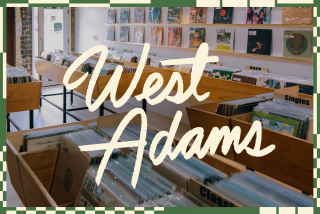Little Bangladesh must grow into its name
- Share via
A new sign hangs at the corner of 3rd Street and New Hampshire Avenue in Central Los Angeles: Little Bangladesh.
Just behind it is a small shopping plaza with a Salvadoran restaurant, a pizza joint, a former Korean cigarette shop and a restaurant that serves teriyaki chicken, burritos and boba drinks. Across the street are more Korean- and Mexican-themed businesses.
The nearest store with a clear connection to Bangladesh, Bengal Liquors, is a block away. All told, there are fewer than a dozen shops owned by or catering to Bangladeshis along this working-class commercial strip flanked by apartment buildings.
Muhammad “Shamim” Hussain, a leader of the local Bangladeshi community, said that although the sign is significant, the community must work to make the idea behind it a reality. “The sign is the symbol,” said Hussain, who came to the U.S. in 1981.
Community leaders applied for the neighborhood recognition more than a year ago. At first, the goal was much grander: to designate a 56-square-block area from 3rd to Wilshire Boulevard and from Western Avenue to Vermont Avenue — an area generally considered part of Koreatown — as Little Bangladesh.
The Korean community, which had not previously sought an official designation for the area, countered with its own application. And when the City Council voted on the matter in August, the Bangladeshis got only a four-block stretch of 3rd Street between Alexandria and New Hampshire avenues as their own.
But that strip doesn’t yet have the look or feel of a Little Bangladesh. Most stores in the area cater to a Korean or Latino clientele, and many of the dozen or so Bangladeshi stores are blocks away. Aside from a handful of restaurants and grocery stores, the neighborhood features almost no other Bangladeshi shops or services: no clothing boutiques selling salwar kameez, the traditional two-piece attire worn by both men and women; no jewelry shops for bangles; no souvenir shops; no salons offering henna and threading services. And since it closed about a year ago, no community center either.
Since they began their effort, local Bangladeshis have been trying, with limited success so far, to open and relocate businesses to the area, both to show their presence and to provide needed services for the thousands of lower- to middle-income Bangladeshi immigrant families who live there. On any given day, women in brightly colored traditional dress can be seen walking the tree-lined residential streets, often pushing strollers or accompanied by small children. On the weekends, they are joined by men also wearing salwar kameez, but in white or beige.
Although the number of Bangladeshi businesses in the area hasn’t risen quickly, the neighborhood designation is an acknowledgment of the local Bangladeshi presence and recognition that it has been positive, said Manju Kulkarni, executive director of the South Asian Network, a cultural and advocacy group with an office nearby.
The network estimates the current Bangladeshi population in the area at more than 20,000, based on a community mapping project it did five years ago.
“Now the people, they are going to say, ‘This is my place, I have to build it up’ … because this is the biggest news of our history in the U.S.,” said Maminul “Bachu” Haque, who owns a travel agency a few blocks away and is interested in relocating to the new district. He moved from Bangladesh to the U.S. in 1983.
Councilman Tom LaBonge, who represents the area, led the effort to forge a compromise between the Bangladeshi and Korean communities. LaBonge said he had initially wanted to designate a stretch of 3rd Street as an “international mile” because of its Korean, Salvadoran, Oaxacan and Bangladeshi shops and restaurants. But the Bangladeshis were insistent, he said.
Chang Lee, Koreatown development chairman for the L.A. Korean American Chamber of Commerce, was among those from the Korean and Bangladeshi communities who toured the area with LaBonge a year ago to decide on the boundaries for the new neighborhood designation. He said he expected it to take a while for the relative newcomers to establish as many businesses as his compatriots have during their 40-year presence in the area.
“Their stay in that area is not that long, so it will take some time,” Lee said of the Bangladeshis. “It’s their responsibility to turn that into Little Bangladesh, not just having the name for the name’s sake.”
There are some signs of progress. The new owner of the 99-cent store at 3rd and Ardmore Avenue plans to open a halal butcher shop next door, catering to the area’s new Muslim residents. And a halal butcher nearby is looking to open a restaurant. Other Bangladeshi merchants are looking at every open storefront but say the rents are too high.
The community regards Little India in Artesia as a model. Although Little India, unlike Little Bangladesh, doesn’t have an official county designation, it is known across the region as the place to go for saris, gold jewelry and Indian food. The new neighborhood must work to establish that kind of recognition, its leaders said.
When people come to the area, Hussain said, they should enjoy a full Bangladeshi experience.
On Dec. 16, the anniversary of Bangladesh’s 1971 victory over Pakistan in its war of independence, residents hope to close several blocks of 3rd Street for a celebration. By then, they hope the Bangladeshi-owned businesses along the strip — even those catering to a Latino clientele — will feature signs in Bangla.
In a cramped second-floor apartment one block north of 3rd, Taslimah Parveen sells formal and casual salwar kameez she brings back from annual trips to Bangladesh. When customers arrive, she brings out large plastic bins full of the folded two-piece outfits, many of them beaded.
For the last few years, Parveen has been looking for a small shop where she could open a boutique instead of selling the clothing in her living room or driving to Little India.
Many of the Bangladeshi women she knows make the drive to Artesia for such things as threading, a hair removal method, or henna at an accommodating salon. Many end up “spending $20 on gas to do a $5 threading,” her daughter, Mahajabeen Mahtab, said.
Parveen has looked at four or five stores, but rents that were already too expensive at $2.50 per square foot have risen to $3 and higher, her daughter said. The area’s comparatively high rents were the reason for the closure last year of the community center that had stood for several years near Deshi, a popular grocery and restaurant featuring Bangladeshi and Indian food, Hussain said.
“I think we need the whole boutique thing, the culture,” Mahtab said. “I think they can do a lot better. I think they can get a lot more stores. But it’s tough.”
More to Read
Sign up for Essential California
The most important California stories and recommendations in your inbox every morning.
You may occasionally receive promotional content from the Los Angeles Times.










